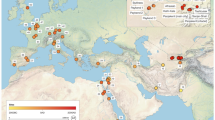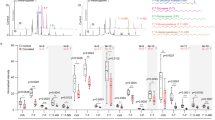Abstract
MANY insects contain carotenoid pigments1, and some notable examples are found in the Coleoptera, where carotenoids are responsible for the yellow colour of the yellow and black striped wing cases of the Colorado beetle, Leptinotarsa decemlineata, and the orange-red colour of the ladybird beetles, Coccinella spp. There has, however, been no report of any insect species being able to synthesise carotenoids de novo, and it is generally accepted that in insects, as in other animals, any carotenoids present are of dietary origin2. In July 1976 the Liverpool area, like many regions of the UK, experienced an invasion by enormous numbers of ladybirds, almost entirely of the seven-spot variety, Coccinella septempunctata. With such large numbers of insects available we were able to use modern analytical techniques to identify the carotenoids of these beetles. We report here that the carotenoids identified were mostly hydrocarbons, and the carotenoid pattern indicated that these pigments in the ladybird are likely to be of microbial rather than plant origin, thus suggesting the involvement of symbiotic microorganisms.
This is a preview of subscription content, access via your institution
Access options
Subscribe to this journal
Receive 51 print issues and online access
$199.00 per year
only $3.90 per issue
Buy this article
- Purchase on Springer Link
- Instant access to full article PDF
Prices may be subject to local taxes which are calculated during checkout
Similar content being viewed by others
References
Goodwin, T. W. in Chemical Zoology VI, Arthropoda B(eds Florkin, M. & Scheer, B. T.), 290–306 (Academic, New York, 1971).
Goodwin, T. W. The Comparative Biochemistry of the Carotenoids (Chapman and Hall, London, 1952).
Lederer, E. Bull Soc. Chim. biol. 20, 567–610 (1938).
Valadon, L. R. G. & Mummery, R. S. Comp. Biochem. Physiol. 46 B, 427–434 (1973).
IUPAC Commission on the Nomenclature of Organic Chemistry, and IUPAC-IUB Commission on Biochemical Nomenclature, Nomenclature of Carotenoids (Recommendations 1974) Biochemistry 14, 1803–1804 (1975).
Britton, G. in Chemistry and Biochemistry of Plant Pigments 2nd edn. 1 (ed. Goodwin, T. W.) 262–327 (Academic, New York, 1976).
Andrewes, A. G. et al. Acta Chem. Scand. 25, 3878–3880 (1971).
Arpin, N., Fiasson, J.-L., Bouchez-Dangye-Caye, M. P., Francis, G. W. & Liaaen-Jensen, S. Phytochemistry 10, 1595–1601 (1971).
Lederer, E. Bull. Soc. Chim. biol. 20, 611 (1938).
Davies, B. H. & Taylor, R. F. Pure appl. Chem. 47, 211–221 (1976).
Weisgraber, K. H., Lousberg, R. J. J. C. & Weiss, U. Experientia 27, 1017–1018 (1971).
Henry, S. M. Symbiosis 1 & 2 (Academic, New York, 1966 & 1967).
Author information
Authors and Affiliations
Additional information
The erratum article can be found online at https://doi.org/10.1038/267290c0
Rights and permissions
About this article
Cite this article
BRITTON, G., LOCKLEY, W., HARRIMAN, G. et al. Pigmentation of the ladybird beetle Coccinella septempunctata by carotenoids not of plant origin. Nature 266, 49–50 (1977). https://doi.org/10.1038/266049a0
Received:
Accepted:
Published:
Issue Date:
DOI: https://doi.org/10.1038/266049a0
This article is cited by
-
Multimodal signal interactions in the ladybeetle, Hippodamia convergens, aposematic system
Chemoecology (2015)
-
The role of carotenoids and their derivatives in mediating interactions between insects and their environment
Arthropod-Plant Interactions (2013)
-
Elytra color as a signal of chemical defense in the Asian ladybird beetle Harmonia axyridis
Behavioral Ecology and Sociobiology (2007)
Comments
By submitting a comment you agree to abide by our Terms and Community Guidelines. If you find something abusive or that does not comply with our terms or guidelines please flag it as inappropriate.



